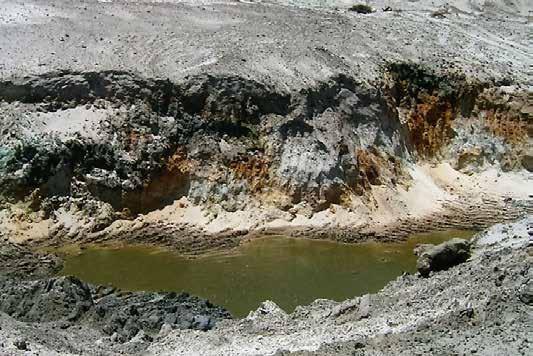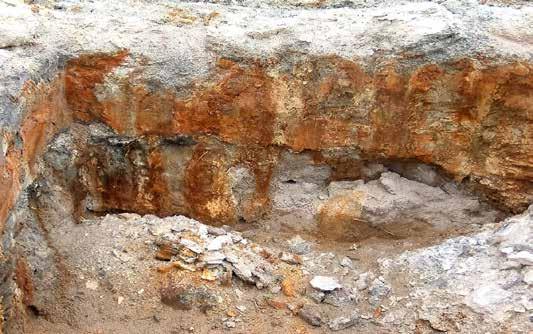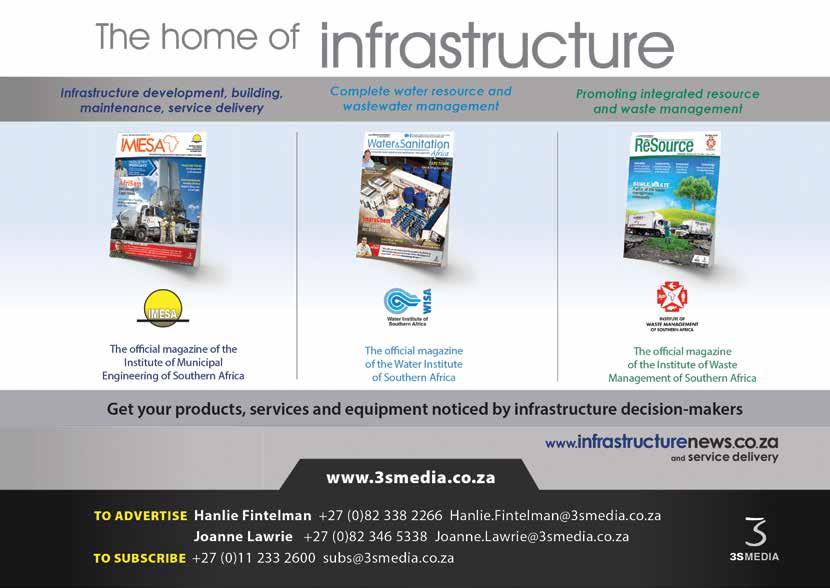
4 minute read
GROUNDWATER
from ReSource May 2020
by 3S Media
Determine leachate risk before drilling
Contamination from petroleum hydrocarbons and industrial solvents is not easy to trace to a particular source
Advertisement
Companies and municipalities looking to use groundwater as a path to water resilience need to pay careful attention to the risk of contamination from leachates before rushing into drilling boreholes. This is according to Richard O’Brien, principal environmental geochemist at SRK.
The contamination of groundwater by leachate from various sources becomes more of an issue as municipalities and businesses try to become ‘water resilient’


If contamination has occurred in the upper layers, which are not adequately sealed off from the aquifers below, cross-contamination can occur
ertain chemicals that can C contaminate groundwater can make water from these sources unfit for their intended use. Furthermore, the cost of treating contaminated water once pumped to surface could be prohibitive – rendering the whole exercise unsustainable.
Many older municipal landfills were not required by law to include liners, so it is not uncommon for rainwater to percolate through the waste material and create an acidic leachate capable of affecting groundwater aquifers. While many legacy landfills in certain urban areas have been identified by government and remediated, there are probably many more in rural regions that remain unattended. Mines’ tailings storage facilities – or tailings dams – pose a similar challenge, with a regulatory requirement for liners in certain conditions being introduced only in recent years.
Legacy
O’Brien notes that there are also legacy issues related to how other industries traditionally disposed of their waste, in terms of the prevailing legislation and what was considered good practice in the past. The result has been contamination plumes that have the potential to affect water resources.
“The contamination of groundwater by leachate from various sources becomes more of an issue as municipalities and businesses try to become ‘water resilient’ in the face of growing demand and greater rainfall variability,” he explains. “Sourcing groundwater of the required quality is therefore no simple matter, especially as the usual local drinking water standards like SANS 241 can miss toxic contaminants in the water.”
Contamination from petroleum hydrocarbons and industrial solvents are some of those that, while being fairly common, are also not easy to trace to a particular source. They could emanate from a variety of sources such as wash bays, industrial storage, oil-water separators, poor waste management and legacy operations, for instance. He highlights the difficulty, therefore, of finding a culprit once the contamination has been discovered – especially in a densely populated industrial zone.
“The legal remedy in these cases is seldom fruitful,” he continues. “There are simply too many variables, technicalities and loopholes to prevent any specific party being held accountable.”
With the balance of evidence being almost impossible to establish, companies sourcing groundwater from a new borehole frequently have no option but to shoulder the costs of water treatment. Such treatment, however, is not always commercially viable, and there are no ‘silver bullets’. Sometimes, the only solution is to apply multiple treatment technologies – a process that can quickly become too expensive to be worthwhile. The implications can be severe for companies using water for food production, where even the taste and smell may render the water unusable in food or drink applications.
Vulnerability
Often, water supply drillers can aggravate the problem by drilling through a shallow water table in search of a stronger-yielding borehole. If contamination has occurred in the upper layers, and these upper layers are not adequately sealed off from the aquifers below, cross-contamination can occur.
“This highlights the importance of groundwater and source vulnerability – which needs to be explored well before any borehole drilling is contemplated,” says O’Brien. “Investigating possible areas of vulnerability means understanding what other activities in the area could affect the quality of your groundwater.”
While formal source vulnerability assessments are often conducted for large water supply projects to assess yields, they seldom include potential contaminant sources and water quality. This is particularly important for industrial users,

given the potential contaminant sources in industrial areas, to check that the water quality is suitable for its intended use.
The process offers the user a better understanding of the demands and threats to the available water sources. It also helps in identifying alternative water sources that may be available to alleviate any threats to the primary resources. These options would consider both groundwater and surface water as potential resources.
“On the strength of a solid assessment, the user can then develop a source-water protection plan,” he continues. “This would be put in place to protect and manage the sustainable supply of water to users and consumers.”
O’Brien emphasises that this vulnerability to leachates could pose significant risks to municipalities, given the evidence that many will contract borehole drillers without the engagement of geohydrologists and other expert scientists. The discovery of contamination after a borehole has been constructed could place an additional burden on municipal funds.
“If any user’s water strategy is reliant on groundwater, it is vital to conduct effective vulnerability assessments – both before any borehole drilling programme and during the life cycle of the water project,” he concludes.










